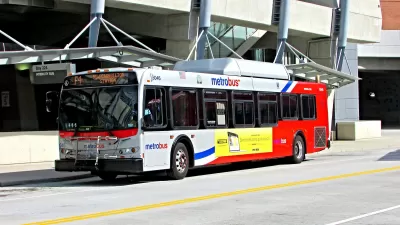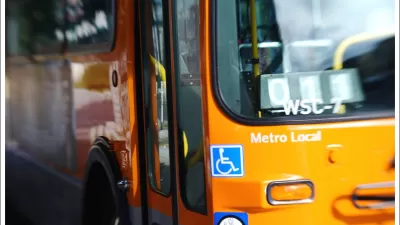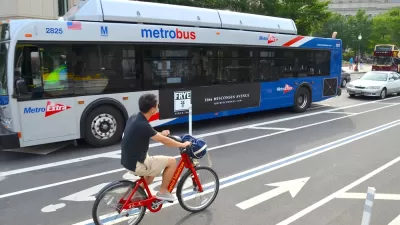Regional governance and more bus lanes are needed to improve ridership, according to a new study.

Faiz Siddiqui reports on initial findings from an analysis of Washington D.C.’s regional bus network that seeks to identify the reasons for declines in ridership.
The study, a joint effort between the Eno Center for Transportation and the Boston Consulting Group, finds that bus lanes have not been a priority in the metropolitan region and, as a result, bus speeds have decreased and led to $30 million of additional labor and fuel costs.
The analysis also provided detailed characteristics about Metrobus riders, who make up about three-quarters of the region’s bus riders. Almost half are low-income and travel during off-peak times, most live in the District, and 85 percent do not transfer to the rail system.
"[The project] will likely recommend a more regional governance structure and a clearer delineation of funding sources — rather than disparate jurisdictional bus subsidies covering routes in their municipalities," says Siddiqui.
FULL STORY: Region’s bus network is too slow, complex, and increasingly threatened by competition, analysis says

Alabama: Trump Terminates Settlements for Black Communities Harmed By Raw Sewage
Trump deemed the landmark civil rights agreement “illegal DEI and environmental justice policy.”

Study: Maui’s Plan to Convert Vacation Rentals to Long-Term Housing Could Cause Nearly $1 Billion Economic Loss
The plan would reduce visitor accommodation by 25% resulting in 1,900 jobs lost.

Why Should We Subsidize Public Transportation?
Many public transit agencies face financial stress due to rising costs, declining fare revenue, and declining subsidies. Transit advocates must provide a strong business case for increasing public transit funding.

Paris Bike Boom Leads to Steep Drop in Air Pollution
The French city’s air quality has improved dramatically in the past 20 years, coinciding with a growth in cycling.

Why Housing Costs More to Build in California Than in Texas
Hard costs like labor and materials combined with ‘soft’ costs such as permitting make building in the San Francisco Bay Area almost three times as costly as in Texas cities.

San Diego County Sees a Rise in Urban Coyotes
San Diego County experiences a rise in urban coyotes, as sightings become prevalent throughout its urban neighbourhoods and surrounding areas.
Urban Design for Planners 1: Software Tools
This six-course series explores essential urban design concepts using open source software and equips planners with the tools they need to participate fully in the urban design process.
Planning for Universal Design
Learn the tools for implementing Universal Design in planning regulations.
Smith Gee Studio
Alamo Area Metropolitan Planning Organization
City of Santa Clarita
Institute for Housing and Urban Development Studies (IHS)
City of Grandview
Harvard GSD Executive Education
Toledo-Lucas County Plan Commissions
Salt Lake City
NYU Wagner Graduate School of Public Service





























